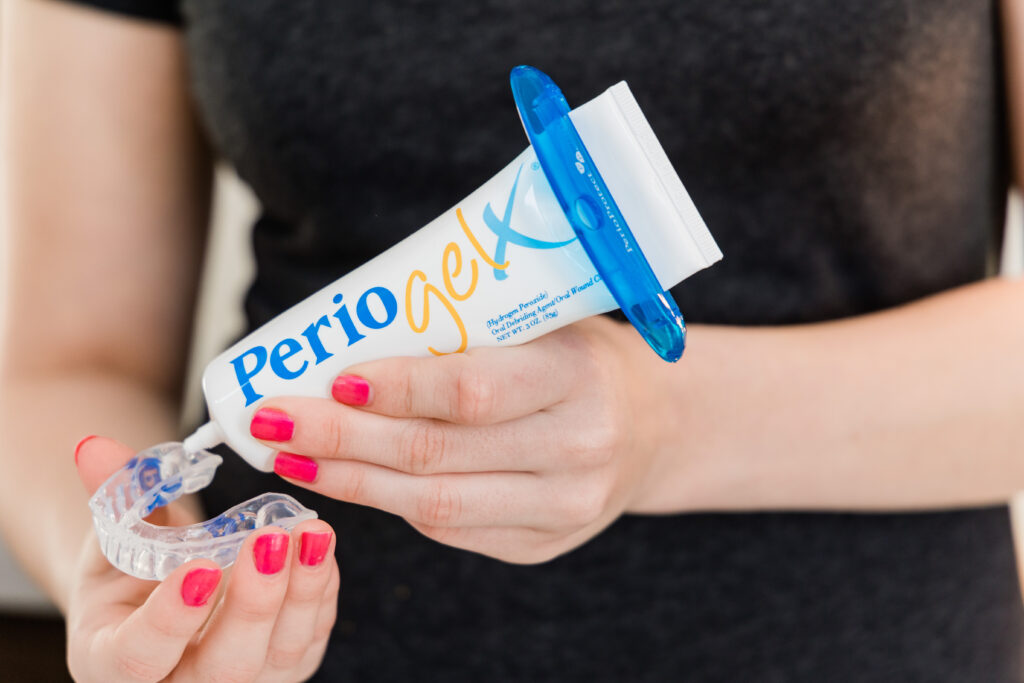His mother was in the chair. The first surgery had gone well. He congratulated her and recommended she schedule the next appointment. She refused. Couldn’t he do something else that would help?
How many times have you referred patients for specialized surgical care, treatment they need, but refuse? Patients cannot always avoid surgery, but the request from his mother started Duane Keller on a mission to find a solution to improve his patients’ gingival health. The result was the creation of a periodontal medicament carrier and a new sector in dentistry led by Perio Protect.
After attempting multiple delivery methods, Dr. Keller designed a comfortable tray with an internal peripheral seal to deliver and hold medication deep in periodontal pockets. Perio Tray™ delivery proved to be easy to use and reliably effective.

Controlled clinical trials show that the patented Perio Tray™ design and adjunctive treatment methodology significantly reduces pocket depths, bleeding, and inflammation. [i] Additional study demonstrates benefits to refractory maintenance patients who have already completed surgery. [ii]
The research results are important because antibiotics are limited. Antibiotics have been prescribed for decades and still we have high rates of disease. By the time Americans are 65 years old, 70% of them have chronic periodontitis resulting in chronic oral inflammation that taxes their immune system.
In fact, our reliance on antibiotics may do more harm than good, promoting antibiotic resistance and unwanted side effects. 13.7% of all Emergency Room visits result from antibiotic adverse drug events. [iii] Dentists write more than 25 million antibiotic scripts a year and are the number one prescriber of clindamycin which is associated with the highest rates of C diff infections. [iv]
As an alternative to antibiotics, consider prescribing Perio Gel™ 1.7% hydrogen peroxide administered deep below the gums via Perio Tray™ delivery. Hydrogen peroxide is an effective broad-spectrum antimicrobial that has been used for more than 100 years in dentistry with a safe track record. [v]
Implementing Perio Tray™ therapy is easiest when you focus on bleeding points. How many bleeding points are acceptable for your patients? It’s an important question. Bleeding on probing (BOP) data is readily available to the dental team, and years of research has shown that continuous absence of bleeding on probing is a reliable predictor for the maintenance of periodontal health or, stated differently, for no further periodontal damage. [vi]
If we accept that bleeding on probing is an important clinical assessment for periodontal health and maintenance, focusing on the number of bleeding points gives us an easy predictor, quickly calculated from data that has already been collected. If you know how many bleeding points are acceptable, then you know who a good patient candidate is and why you are prescribing Perio Tray™ therapy: because it’s important to treat infected tissue.
So, what’s your number?
How much bleeding is acceptable in your practice? If you have a number that serves as a threshold, or standard of health, you know that everyone above it deserves more attention and treatment. It’s not realistic that every patient will get to zero bleeding points, but you should get to single digits with Perio Protect.
A focus on BOP will also help diagnosis disease. Periodontal disease is one of the most under-diagnosed diseases in North America. Using a simple number to help focus attention and treat disease in the earliest stages will significantly improve patient health and wellness.
Contact Perio Protect to schedule a team meeting and planning session for your practice. The session will help you establish your standard of health and get buy-in from your team so that they can implement Perio Tray™ therapy.
Visit Perio Protect to learn more!
Works Cited:
[i] Putt M, Mallatt M, Messmann L, and Proskin H. A 6-month clinical investigation of custom tray application of peroxide gel with or without doxycycline as adjuncts to scaling and root planning for treatment of periodontitis. American Journal of Dentistry. 2014;27:273-284. Putt M and Proskin H. Custom Tray Application of Peroxide Gel as an Adjunct to Scaling and Root Planing in the Treatment of Periodontitis: Results of a Randomized, Controlled Trial after 6 Months. The Journal of Clinical Dentistry. 2013;24:100-107. Putt M and Proskin H. Custom Tray Application of Peroxide Gel as an Adjunct to Scaling and Root Planing in the Treatment of Periodontitis: A Randomized, Controlled Three-Month Clinical Trial. The Journal of Clinical Dentistry. 2012;23(2):48-56.
[ii] Cochrane RB and Sindelar B. Case Series Report of 66 Refractory Maintenance Patients Evaluating the Effectiveness of Topical Oxidizing Agents. The Journal of Clinical Dentistry 2015;26:109-114.
[iii] https://www.ncbi.nlm.nih.gov/pmc/articles/PMC6025673/
[iv] https://www.osap.org/antibiotic-stewardship
[v] Marshall MV, Cancro LP, Fischman SL. Hydrogen Peroxide: A Review of Its Use in Dentistry. J Periodontol. 1995 Sept;66(9):786-96.
[vi] Joss A, Adler R, Lang NP. Bleeding on probing. A parameter for monitoring periodontal conditions in clinical practice. J Clin Periodontol. 1994;21(6):402-408. Lang NP, Adler R, Joss A, Nyman S. Absence of bleeding on probing. An indicator of periodontal stability. J Clin Periodontol. 1990;17(10):714-721.




